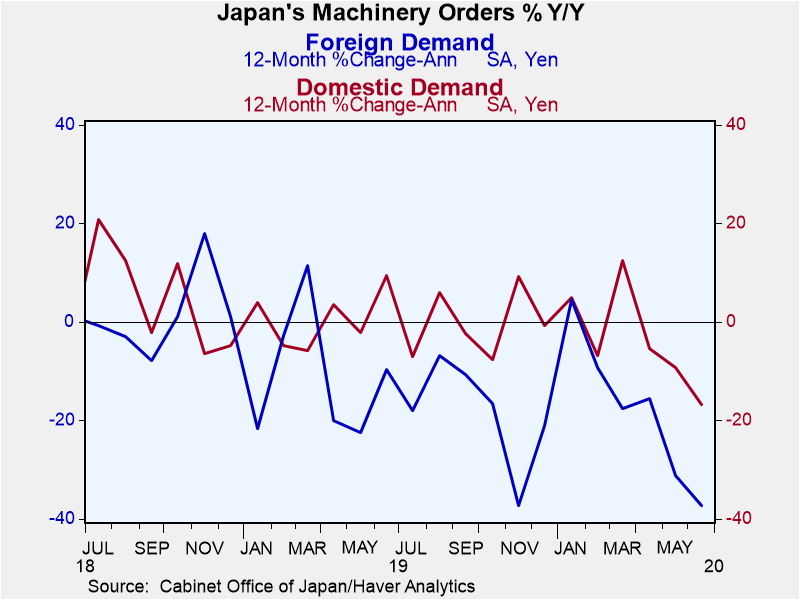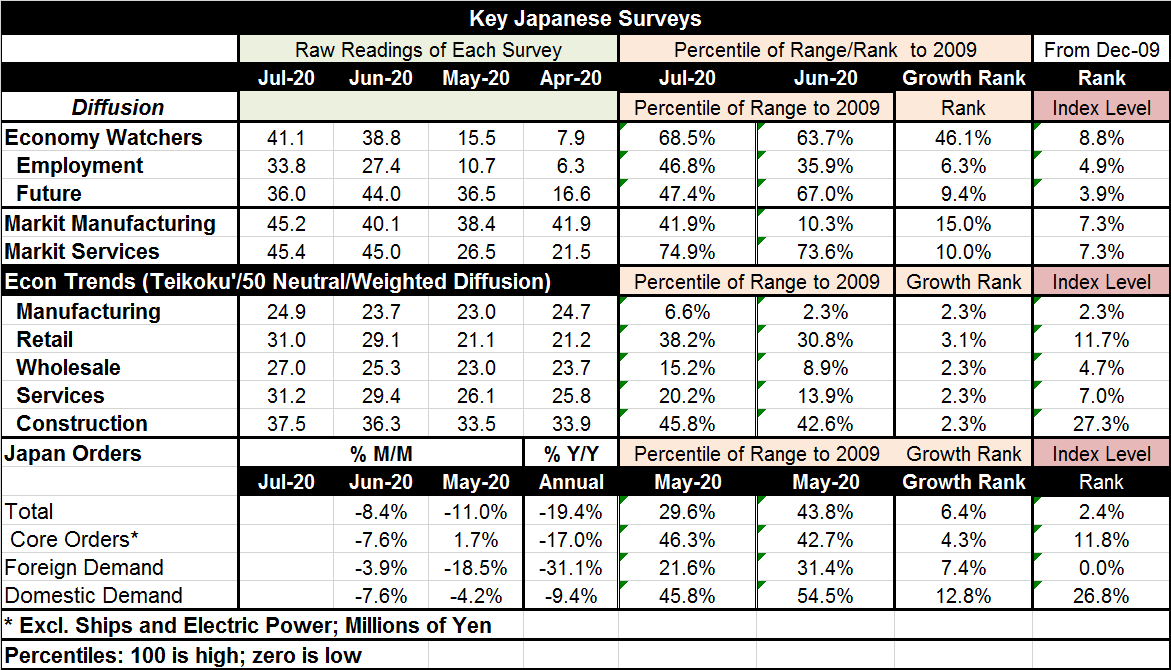 Global| Aug 19 2020
Global| Aug 19 2020Japan's Orders Fall; Core Orders Fall; Foreign Orders Hit a New Low
Summary
The table below pools the data from four different reports to create a picture of how Japan is doing. The pictures all are painted in the same dark colors. The orders data are fresh today even though they lag the data in other surveys [...]
 The table below pools the data from four different reports to create a picture of how Japan is doing. The pictures all are painted in the same dark colors. The orders data are fresh today even though they lag the data in other surveys by one month. All four categories of orders showed declines in June. The ranking of orders across these categories based off year-on-year growth rate leaves three categories in their lowest ten percentile with fourth measure, domestic demand, eking out a ranking in its 12th percentile. All of these are extremely low and depressing results. If we apply the ranking instead to the levels of orders for each category, the results are nearly as depressingly weak. Foreign demand even logs the weakest standing it has seen on data back to December 2009, based on order levels expressed in nominal yen in over a 10 and one-half year period.
The table below pools the data from four different reports to create a picture of how Japan is doing. The pictures all are painted in the same dark colors. The orders data are fresh today even though they lag the data in other surveys by one month. All four categories of orders showed declines in June. The ranking of orders across these categories based off year-on-year growth rate leaves three categories in their lowest ten percentile with fourth measure, domestic demand, eking out a ranking in its 12th percentile. All of these are extremely low and depressing results. If we apply the ranking instead to the levels of orders for each category, the results are nearly as depressingly weak. Foreign demand even logs the weakest standing it has seen on data back to December 2009, based on order levels expressed in nominal yen in over a 10 and one-half year period.
The Teikoku survey, the Markit diffusion measures, and the economy watchers index all tell the same dismal story as for orders. All of these surveys have rank standings since end-2009 largely in their lower 10 percentile with very few and unimportant exceptions. The ranking on the year–over-year growth rates is just as bad with standings largely in the lower ten percentile as well with the only major exception being the economy watchers current index that boasts a below median 46.1 percentile standing for the current conditions metric ranked on growth. The economy watchers raw diffusion reading, however, is even lower at a 41.1 standing, indicating clear on going contraction. All the diffusion readings for July Economy watchers, Teikoku and Markit show all gauges as registering on ongoing contraction.
Japan's gauges have risen from abysmal-to-weak lows in the April-May period, so there has been some progress. But the rebound has not come far enough and most of these gauges still signal a lot of lingering weakness and ongoing contraction. Three of the four order metrics have been declining year-over-year for five months running. Core orders are the exception, having fallen for only four months in a row.
The thing of it for Japan is that there is no silver lining. None of these surveys has a 'yes but' factor operating. The surveys are weak and they are weaker when looked at a different way. And recently Japan has been battling a virus outbreak again. It remains challenged.

Robert Brusca
AuthorMore in Author Profile »Robert A. Brusca is Chief Economist of Fact and Opinion Economics, a consulting firm he founded in Manhattan. He has been an economist on Wall Street for over 25 years. He has visited central banking and large institutional clients in over 30 countries in his career as an economist. Mr. Brusca was a Divisional Research Chief at the Federal Reserve Bank of NY (Chief of the International Financial markets Division), a Fed Watcher at Irving Trust and Chief Economist at Nikko Securities International. He is widely quoted and appears in various media. Mr. Brusca holds an MA and Ph.D. in economics from Michigan State University and a BA in Economics from the University of Michigan. His research pursues his strong interests in non aligned policy economics as well as international economics. FAO Economics’ research targets investors to assist them in making better investment decisions in stocks, bonds and in a variety of international assets. The company does not manage money and has no conflicts in giving economic advice.






